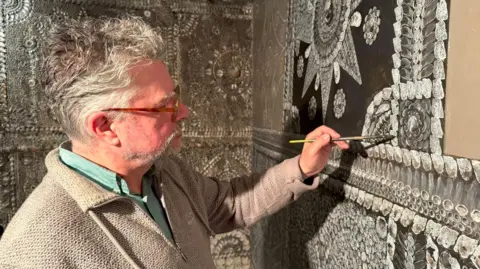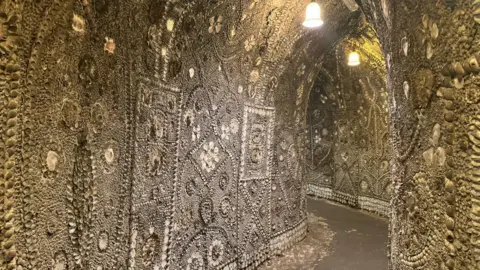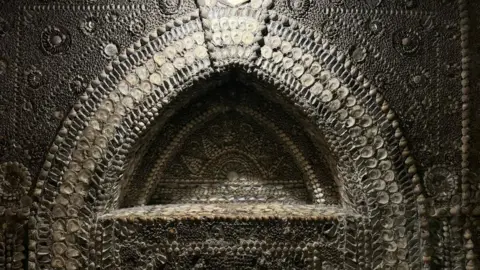Artist's work to restore damaged shell grotto
 Jadzia Samuel/BBC
Jadzia Samuel/BBCAn artist is undertaking painstaking work to restore parts of the original wall of a Kent tourist attraction which was partly destroyed in a bombing raid during World War Two.
Paul Hazelton says he is using old photographs and chalk to recreate the Shell Grotto Margate's east wall.
The grotto is a subterranean passageway which is about 100ft (30m) long and the chalk walls are covered with about 4.6 million shells.
Mr Hazelton, from Margate, told the BBC it was "quite a daunting task" as it was important to preserve the grotto's uniqueness and history.
 Jadzia Samuel/BBC
Jadzia Samuel/BBC"When people visit Margate, the Shell Grotto is a must-see attraction," Mr Hazelton said.
"It's like a pilgrimage so I feel a great responsibility to restore the damaged wall."
When the grotto was rediscovered by accident in the 1830s many visitors flocked to see its wonders.
During World War Two, the cottage above the grotto was bombed, destroying part of the artwork.
Mr Hazelton says he has spent more than 100 hours on the mosaic saying he hopes it will pay homage to the site.
 Jadzia Samuel/BBC
Jadzia Samuel/BBCThe Shell Grotto is shrouded in mystery and historians are still trying to figure out its origins and purpose.
Manager of the grotto, Nicky Paton, said: "There are many theories regarding the history of these shells. They range from the Roman times to the 18th Century."
Other theories suggest they may have been a meeting place of a secret society, or a place of worship.
The shells on the walls include mussels, whelks, oysters, cockles, limpets and razor shells.
Although the shells have lost their colour due to gas lamps used in the 19th Century, the tunnels continue to capture the imagination and fascination of visitors.
Follow BBC Kent on Facebook, on X, and on Instagram. Send your story ideas to [email protected] or WhatsApp us on 08081 002250.
